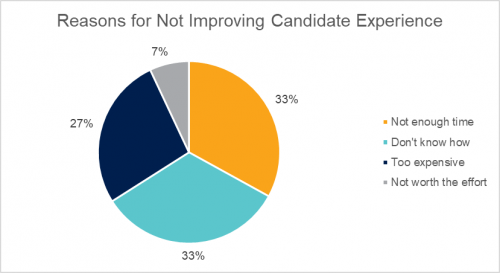We all know that candidate experience is critical to a successful hiring process in today's job market. We’re still deep within a candidate-driven market where employers are facing talent shortages in key roles, and where “ghosting” is on the rise.
But simply knowing that something is a problem doesn’t automatically translate into action. In a recent poll, we asked hiring professionals what the biggest obstacles were to improving candidate experience. We found that 33% didn’t have enough time to work on it; 33% just don’t know how to improve it; 27% considered it to be too expensive; and 7% said it didn’t seem worth it to put in the effort.

What’s reassuring is that that the vast majority (93% total) of respondents agree that improving candidate experience is important and worth the effort, but there are still a number of key barriers preventing them from actually doing it. While these challenges are completely understandable given the day-to-day demands in the workplace, here are a few statistics about the candidate experience that may help turn your inaction into action.
1. 84% of job seekers say a company’s reputation is important.
This isn’t too surprising, since most of us can relate to wanting to work for a company that reflects our values and that has a positive work culture. There’s also some evidence that company reputation may be even more important for millennial and Gen Z applicants.
2. 72% of job seekers who have had a bad experience talk about it, either in an online review or with friends or colleagues.
Someone who has a terrible experience in the hiring process is much more likely to vent about it publicly than someone who has an average or even a great experience. These negative reviews have a cascading effect, impacting how your company is perceived by incoming applicants.
3. 55% of job seekers abandon an application after reading negative reviews online.
This means that all the efforts you put into sourcing candidates could be going to waste the moment a candidate sees one too many negative reviews, stopping them before they can even hit the submit button.
4. 60% of job seekers have quit an application due to its length or complexity.
Aside from just a company’s reputation, the application itself can be a deal breaker for a lot of candidates. If you’re struggling to get enough applicants, don’t place too many hurdles in the application or you’ll experience significant drop-off. However, one silver lining of this is that sometimes long applications can screen out the people who weren’t that interested in the job in the first place.
5. The average time to hire in the US is about 24 days, but top candidates stay available for an average of 10 days before getting hired.
Staying competitive in today’s hiring landscape requires you to be agile and efficient as you move through the hiring process. It’s especially important to act fast when you come across a high-quality candidate that you really like.
6. 95% of candidates would apply again if they had a good experience the first time.
While all of the other statistics may seem a bit dire, the flip side is that a positive experience can improve the perception of your brand and encourage people to apply again, or to get their friends to apply. Providing a good candidate experience doesn’t just help you improve your reputation as a great employer, but it also helps you maintain a pipeline of candidates who could potentially be a great fit for later job openings that come down the line.
Candidate experience doesn’t just affect the impression of your employer brand – it also links directly to the quantity and quality of applicants who decide to apply to your organization. While improving candidate experience is by no means simple, taking a few small steps in the right direction goes a long way.
Want to learn more strategies for improving the candidate experience? Watch our webinar on-demand.




